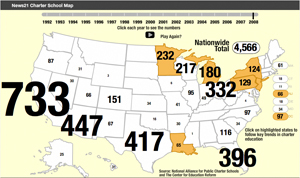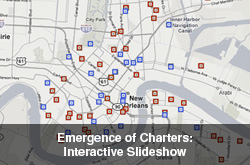Refuge on the Reservation
Jamie Oppenheim | Jul 30, 2009 | Comments 3
Educators have long worried about the grim statistics surrounding American Indian high-school students. Dropout rates in particular have remained stubborn and high, according to the U.S. Department of Education. Fifteen percent of American Indian kids nationwide drop out of school, a rate second only to Hispanic students, at 21 percent.
In Michigan, the situation is even more dire. There, 20 percent, or one in five, American Indians does not finish high school. These troubling statistics reflect the Indians’ long, rocky relationship with formal education.
It began in the 1870s with the infamous government boarding schools. There Indian children were forced to shed their families, their language, their customs, their dress, and every other aspect of their culture to become civilized Americans.
More recently, when two Upper Peninsula Indian reservations decided to create two public charter schools on their reservations, they did so in spite of this painful history. Their mission? To use state funding to renew and celebrate Indian culture, rather than to eradicate it. The end goal? Rescuing children in danger of dropping out.
One charter is in Hannahville, a reservation on the southwest side of the Peninsula, 10 miles outside Escanaba, the largest urban center in the area. In 1976, with financial support from the Bureau of Indian Affairs, the tribe opened the Hannahville Indian School. Then in 1995, it was converted into a charter which came with additional state funding. Today, the school serves 175 students, more than half of whom are Native American, and offers Indian culture and Potowatomi language classes.
The second charter was founded in 2003 on Ojibwe tribal land along the banks of Lake Superior. Its founders wanted to offer an alternative to the nearby Brimley public school, where American Indian children had long felt less than welcome by other students. The hostile treatment there had driven large numbers of kids out of school. The Ojibwe Charter School currently serves 88 students, and graduated its first high-school class of five students last year.
There is no data yet to determine whether these charter schools are reversing decades of educational neglect for these children. The Michigan Department of Education began tracking dropout rates by race and ethnicity only last year.
But in 2008, 22.2 percent dropped out of the Nah Tah Wahsh Public School Academy, down from 27 percent the year before.
The Ojibwe Charter School reported a 66 percent dropout rate for its first graduating class and 50 percent dropout rate for students who started high school in 2005.
I met three students from both of the schools last spring. Elijah Jesse and Pete Meshigaud are both 17. Chelsea Sagitaw is 15. Each recounted why they left their more diverse public schools for exclusively Native American charters. Click to hear their stories.
Filed Under: Reshaping Communities
About the Author:














It’s just unfair for native Americans.
thank you share with me
[...] out this story, Refuge on the Reservation, about three teenagers who are growing up on a reservation and attending an American Indian Charter [...]